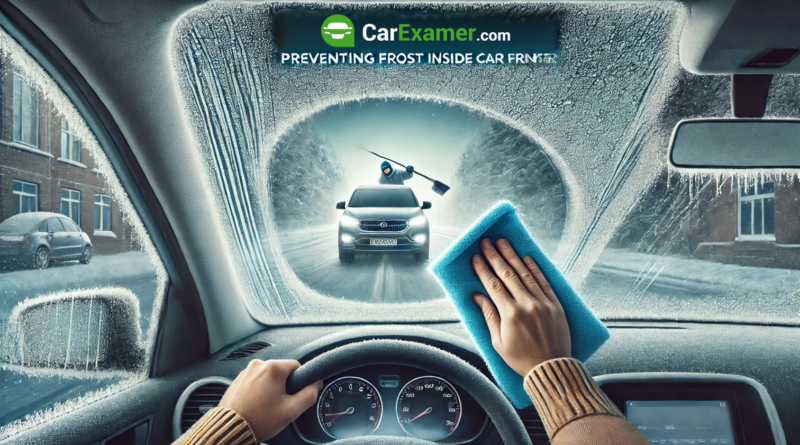How to Stop Your Car Windscreen from Freezing on the Inside
Let’s break down how to stop car windscreen from freezing on the inside and give you some simple, practical tips to prevent it from happening again. We’ve all been there: you hop into your car on a frosty morning, only to discover that the inside of your windscreen is frozen. It’s not just annoying—it’s dangerous if you can’t see out properly. But why does it happen, and more importantly, how can you stop it?
Why Does Your Windscreen Freeze on the Inside?
The inside of your windscreen freezes because moisture inside your car condenses and turns to frost in cold weather. Here’s why:
- Trapped moisture: Wet clothes, snow on your shoes, or even the moisture from your breath can build up inside your car.
- Cold temperatures: When it’s cold enough outside, the temperature inside your car can drop below freezing, turning any moisture into frost on the windscreen.
- Poor ventilation: If your car isn’t well-ventilated, humidity levels rise inside the cabin, leading to condensation that freezes when it gets cold enough.
How to Stop Your Windscreen from Freezing on the Inside
Here are some easy and effective ways to prevent your windscreen from frosting up on the inside:
1. Dry Out the Inside of Your Car
Moisture is the main culprit here, so keeping the inside of your car as dry as possible is key.
- Remove wet items: Don’t leave wet coats, umbrellas, or snow-covered items inside your car. They release moisture into the air as they dry, which then collects on your windows.
- Use absorbent floor mats: These will catch any snow or water from your shoes and can be removed to dry out. This helps reduce moisture buildup inside the car.
- Wipe down the windows: Before you leave your car for the night, take a second to wipe down the windscreen and windows to remove any moisture.
2. Use a Car Dehumidifier
A car dehumidifier is a simple, effective tool for reducing moisture inside your vehicle. These small bags are filled with moisture-absorbing materials, like silica gel, and can be placed on your dashboard or under the seats to soak up excess humidity.
Bonus: most of these are reusable. Simply dry them out on a radiator or in the microwave, and they’re good to go again.
3. Ventilate Your Car
Good airflow can help lower the humidity in your car, preventing frost buildup on the inside.
- Turn on the air conditioner: Even in the winter, running your air conditioner helps pull moisture out of the air inside your car. Use the defrost setting with the air conditioner to dry out the air while keeping the car warm.
- Crack the windows briefly: Letting a bit of fresh air in can help equalize the humidity inside your car with the outside air. Just a few minutes can make a difference.
- Leave your car vented: If it’s safe to do so, try cracking the windows slightly when you park overnight to allow moisture to escape.
4. Prevent Moisture Buildup
Stopping moisture from getting inside your car in the first place is a big step in preventing frosty windows.
- Check for leaks: Make sure your car doesn’t have any leaks, like faulty door seals or cracked windows. Even a small leak can let in moisture, increasing the chance of frost forming.
- Brush off snow and ice: Before you get into your car, shake off as much snow as you can from your clothes and shoes. This will reduce the amount of moisture you bring into the car.
5. Keep Your Windscreen Clean
A clean windscreen is less likely to attract moisture and frost.
- Apply an anti-fog solution: These products create a protective layer on your windscreen, helping to repel moisture and reduce the chance of condensation turning into frost.
- Vinegar and water solution: You can also make a simple solution at home by mixing 3 parts vinegar to 1 part water. Spray it onto your windscreen and wipe it clean—this can help prevent frost buildup.
6. Park in a Garage or Use a Windscreen Cover
If you have access to a garage or carport, parking your car inside will prevent frost from forming on the inside and outside of the windscreen.
- Windscreen cover: If you don’t have a garage, a windscreen cover can help protect your car overnight. While it won’t stop moisture from building up inside, it will keep frost off the windscreen, saving you time in the morning.
7. Run the Air and Heat Before Parking
Before you park your car at the end of the day, make sure to warm up and dry out the inside a bit.
- Run the heater and air conditioner: Turn on the heater to warm the air, then run the air conditioner for a few minutes to remove moisture. This helps dry out the cabin, reducing the chance of frost forming overnight.
Final Thoughts
Dealing with a frosty windscreen on the inside is frustrating and can be dangerous if it obstructs your view. By keeping your car dry, ventilated, and using tools like a dehumidifier or windscreen cover, you can prevent frost from forming and save yourself time in the mornings.
Buying a used VW. Buying used vauxhall, BMW, Jaguar, Ford, Volvo, Range rover, Bentley, Aston Martin, Porsche, Ferrari, Lamborghini, Maserati, Hyundai, Tesla, Honda, Pagani

